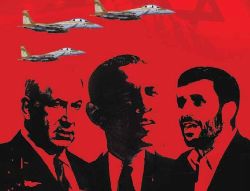The terror strike on an Israeli diplomat brought the Iran-Israel shadow war to the streets of Delhi. Any crisis in the Persian Gulf would dramatically escalate the price of oil and thereby seriously impact on the Indian and global economy. The price of oil could easily cross US$ 200 per barrel and more. Over 68 per cent of India’s oil supplies and 100 per cent of its gas are currently sourced from the Gulf region. The US and Europe are now putting in place economic sanctions to target Iran’s oil exports. Iran in turn has threatened to block the Straits of Hormuz in retaliation. Any Iranian attempts to close the Gulf of Hormuz could seriously impact the Chinese, Indian, Japanese and South Korean economies. Such an economic crisis would be pushing the envelope too far and there is now a need for a frank dialogue between us and our strategic partners. This article analyses the likely shape and contours of an Israeli military strike on Iran and its huge consequences. A clear and present danger is looming and there is a dire need to anticipate events and defuse the crisis before it overtakes us.
 |
| Click to enlarge |
 |
| Here you can find more information about XXX |
There is a looming crisis gathering over the Persian Gulf. Israel is getting restive over the Iranian quest for a nuclear weapons capability and is seemingly preparing for a military strike to knock out the Iranian nuclear facilities. This shadow war between Iran and Israel reached New Delhi with the terror attack on the Israeli diplomat within earshot of the Prime Ministers residence at 7 Race Course Road. Far more critical than this terror escalation however, is the prospect of a conventional conflict between Iran and Israel and the disastrous impact it could have on our energy security. With the recently concluded war in Iraq and the still ongoing engagement in Afghanistan, the US has apparently little appetite for another war in the Persian Gulf so soon — especially one that could spin out of control. In 2007-08 the US had made naval show of force deployments in the Persian Gulf to coerce Iran into calling off its nuclear programme. US air strikes then would certainly have put back the Iranian nuclear programme by a few years.
However, the fear of Iranian retaliation, primarily through means of asymmetric warfare options and its capability to target shipping / oil lanes in the Gulf, threatened to entrain an escalator where the endgame would have become highly risky. It could have derailed the global economy and generated a worldwide recession with the price of oil soaring beyond the US$ 200 a barrel mark. So America had clearly backed off then.
The US intelligence estimates stated thereafter that Iran had halted its drive for nuclear weaponisation. The world had heaved a sigh of relief and there was a visible deescalation in the strident rhetoric for then. There are however some indications of a change in the scenario once again. When the military option was taken off the table in 2007, the Israeli intelligence was given a free hand and virtually unlimited funds to target the Iranian nuclear programme and scientists. Meir Dagan, the head of the Mossad was given a three years extension to hit the Iranian programme. So far five very senior Iranian nuclear scientists have been assassinated alongwith the head of the Iranian missile programme. The Stuxnet virus was used to infect the Iranian Uranium enrichment facility and serious acts of sabotage hit the Iranian missile production programme. Meanwhile in Sepember 2007 itself the Israeli Air Force had struck the Syrian nuclear facility at Al Kabir and destroyed it successfully.
When the military option was taken off the table in 2007, the Israeli intelligence was given a free hand and virtually unlimited funds to target the Iranian nuclear programme and scientists. So far six very senior Iranian nuclear scientists have been assassinated. The Stuxnet virus was used to infect the Iranian Uranium enrichment facility and serious acts of sabotage hit the Iranian missile production programme
Israeli rehearsals
In June 2008 Israel had carried out a major military exercise, which appeared to be a full dress rehearsal for a potential bombing attack on Iran’s nuclear facilities. US officials then said that the Israeli exercise appeared to be an effort to develop the country’s long range strike potential and demonstrate the seriousness with which it views Iran’s nuclear programme. Was it another coercive exercise to deter Iran or a full fledged rehearsal for an impending Israeli strike on Iran’s nuclear facilities?
Media reports speculated that over a 100 Israeli F‑15 and F‑16 aircraft had taken part in these manoeuvres over the Eastern Mediterranean over Greece and Crete. The exercise also included Israeli helicopters that could be used to rescue downed pilots. The helicopters and refuelling tankers flew over 900 miles – the approximate distance between Israel and nuclear target sets in Iran.
This article is published with the kind permission of “Defence and Security Alert (DSA) Magazine” New Delhi-India

 von
von 